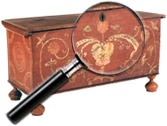|
|
Cabinet Cards
In 1863 the cabinet card photographic image was introduced. This format, in many ways, was similar to its predecessor, the carte de visite, a paper albumen print mounted on card. The principal difference between the two formats was their size. The cabinet card mount measured approximately 6.5 inches by 4.25 inches. The images were slightly smaller measuring approximately 5.5 inches by 4 inches. Sometime in the 1870′s a new larger sized card [...] Click here to continue reading.
Salted Paper Prints
It was Englishman William Henry Fox Talbot who in 1834 developed the photographic process that would become known as Salted Paper Prints. The process involved several steps. First, a good quality writing paper was soaked in a solution of sodium chloride or common salt and then was allowed to dry. After the paper had dried it was covered with a 20% solution of silver nitrate. This solution adhered to the paper’s [...] Click here to continue reading.
Stereograph & Stereoviews
A stereograph or stereoview is a pair of almost identical images mounted side by side on a pasteboard card. The mounted images are then placed in a stereoscope. When viewed the images merge to form one three-dimensional image.
Some of the key names in early stereo photography in the U.S. working in the 1850′s and 1860′s were E. & H. T. Anthony, George Baker, Charles Bierstadt, Matthew Brady, C. D. Fredericks, [...] Click here to continue reading.
Megalethoscope
A room-sized viewing device, the Megalethoscope was invented circa 1860 by Venetian optician and photographer Carlo Ponti. Up to five feet wide, the device showed travel and other photographs using daylight magnified by a large lens. The views were up to twelve inches in width.
Keystone View Company
Stereographs or views are paired images of two slightly different views. These images are created with a two-lens camera. The lenses are offset at about the same spacing as with the distance between human eyes. The dual-lens camera produces paired-stereographic negatives. Load a stereograph into a stereo viewer and the user can see the paired views as if they were a single photograph. Consequently, the stereoscopically combined photographs transform into a [...] Click here to continue reading.
|
Recent Articles
- Charles Alfred Meurer – American Artist & Tromp L’Oeil Artist
- Sendak, Maurice – American Artist & Writer
- Godie, Lee – American Artist
- Davis, Vestie – American Artist
- Bartlett, Morton – American Artist
- Mackintosh, Dwight – American Artist
- Evans, Minnie Jones – African-American Artist
- Mumma, Ed (Mr. Eddy) – American Artist
- Nice, Don – American Artist
- Savitsky, John (Jack) – American Artist
- Gordon, Harold Theodore (Ted) – American Artist
- Dial, Thornton – African-American Artist
- Doyle Sam – American Artist
- Johnson, Lester Frederick – American Artist
- Finster, Howard – American Artist
|
|
